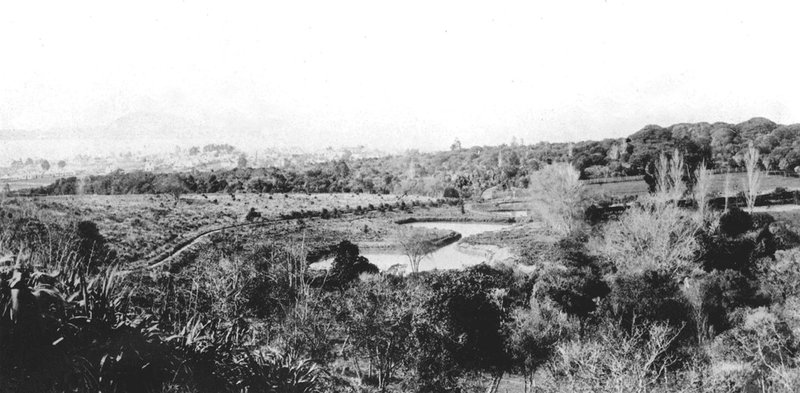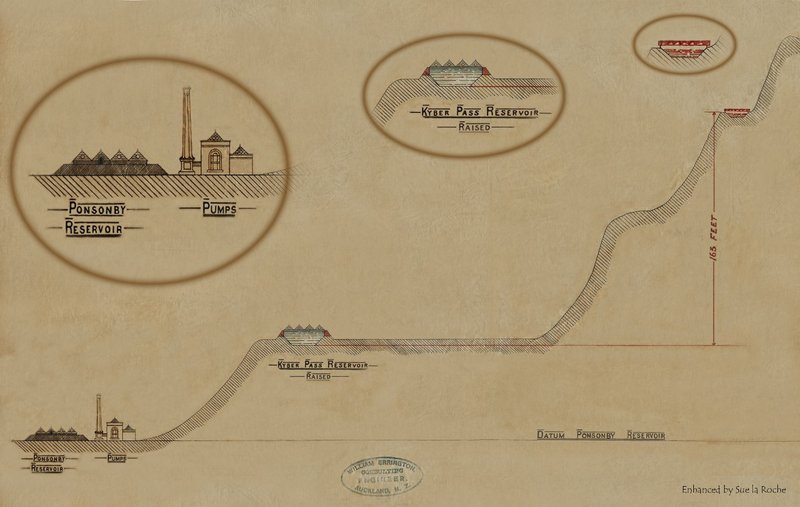The development of water storage and distribution systems has been essential to Auckland’s growth. Auckland’s first water supply scheme, with reservoirs in the Auckland Domain, began operation in 1866. Further reservoirs were later built across the city.
Early pressures and concerns
Early residents in the developing city of Auckland, drew their water from wells, natural springs and personal rainwater collection tanks. Without any sewerage system, wells and streams became polluted. The Waihoritu Stream, which ran down Queen Street, was soon an open sewer. As well as sanitation, fire was a concern. The only water available to put out a blaze was that hand-pumped from a horse-drawn fire truck. In a city built largely of wood, fire had the potential to spread quickly, often with disastrous results.
Auckland Domain reservoir
The first city water supply to be constructed was in the Auckland Domain. Water from natural springs in the Domain were directed into storage reservoirs. Today these reservoirs are the Domain duck ponds. A pipeline took water from the reservoirs to the city, with distribution pipes in Wellesley, Victoria, Wynham, Queen Streets and Albert Street. The system began operation in January 1866.
With dry summers and a growing population, the Domain scheme was soon inadequate. From 1872, the newly formed Auckland City Council was forced to purchase extra water to meet demand. As well as further storage capacity, the council also looked for sites whose height would provide greater water pressure. In 1872, the council purchased properties on the corner of Khyber Pass Road and Symonds Street, and on the corner of Karangahape Road and Ponsonby Road. Today, these remain major water distribution points for the central city.

Water reservoirs in the Auckland Domain, 1860s. Auckland War Memorial Museum. Reference number: PH-ALB-94-p50-2.
Western Springs Reservoir and Pumping Station
In 1874, after much debate, the Auckland City Council decided to progress plans to develop Western Springs as a water storage and distribution point. The scheme, including pumps, boilers, service reservoirs and all associated pipelines, was designed by engineer, William Errington. The scheme was formally opened in July of 1877. Water was pumped to reservoirs at Ponsonby and Khyber Pass and from these high points, distributed to the central city and port area and to Karangahape and Grafton.
The Western Springs pumping station remained in service until 1928, when the water was condemned by the health department. The boilers were removed in 1937.

Detail from 'Ponsonby and Khyber Pass Reservoirs', n.d., City Engineer's Plans, ACC 015 Record [1127] Record ID 579985, Auckland Council Archives.
Mt Eden reservoir
Maungawhau/Mt Eden, one of Auckland’s highest volcanic cones, was an important early water storage site. An Errington-designed reservoir of 50,000 gallons was built near the top of the maunga in 1888. Water was pumped from Western Springs to a reservoir at Khyber Pass and from there up to Mt Eden. The additional pressure provided by the Mt Eden reservoir was used for firefighting in the higher areas of the city such as Newmarket and Parnell.
A second Mt Eden reservoir was completed in 1912. Its construction was not without controversy. Residents expressed concern about the earthworks disfiguring the maunga and work was temporarily halted.
By 1929, further storage capacity was required. Excavation for a third reservoir was undertaken alongside the walls of the second. This resulted in the collapse of a 12-meter section of the reservoir wall, sending 800,000 gallons of water, and with it many tons of rock and scoria, down the mountain causing significant damage to properties and blocking Mt Eden Road.
The subsequent investigation by F W Furkert, Chief Engineer of the Public Works Department, found that the cause of the collapse was corrosion of the reinforcement of the wall to floor joint where water had leaked away unnoticed into the surrounding scoria. The damaged reservoir was promptly repaired and brought back into service, but subsequent enquiries found fault with Auckland City Council officers, their inspection and operational processes.

The bursting of Mt Eden Reservoir as reported in The Auckland Weekly News. Auckland Libraries Heritage Collections AWNS-19290307-35-1
Further storage across the city
In the 1880s reticulated supply to residents was still limited. As each suburb grew, local boroughs put pressure on the city council to supply their district.
Several local bodies developed their own water supply and distribution systems including Onehunga, Mt Roskill, Otahuhu and Māngere. As high points, Auckland’s maunga provided ideal locations for water storage reservoirs and several were constructed across the city including at Maungakiekie/One Tree Hill, Ōhinerau/Mt Hobson and Mt Māngere.
From 1902, water supply became available from catchment areas in the Waitākere Ranges. Demand continued to increase, and additional storage capacity across the city was needed.
Reservoirs built up to that time, designed by William Errington, had been holes in the ground lined with concrete, sloping side walls, an earth embankment and a light corrugated iron roof. Although economical to build, City Engineer, Walter Bush, decided that these Errington designed reservoirs were not economical in terms of space. He designed a new reservoir for Arch Hill in reinforced concrete with vertical walls and a reinforced concrete roof supported by concrete columns. The new Arch Hill reservoir was completed in June 1909, and a new reservoir of similar design, at Khyber Pass in 1910.
By the 1970s, Auckland was drawing water from dams in the Hūnua and Waitākere Ranges. Many of the local body distribution systems became redundant and their associated reservoirs have since been demolished.
Reservoirs and water supply today
Today, Auckland’s water supply is drawn from the Hūnua and Waitākere Ranges and from the Waikato River.
Water service reservoirs still have a part to play in the supply and distribution network. In 2018 there were 85 across the city, eight on Auckland maunga. The engineering of dams, storage reservoirs, pumping systems, supply lines and water treatment facilities has been essential to the health and growth of Auckland city.
More information
References
Firth, C.W. A Century of Water Supply for Auckland, New Zealand. Auckland: Auckland Regional Authority, 1967.
Watercare Services Annual Report, 2018. https://watercareannualreport.co.nz/
Auckland Council Archives
Auckland City Council Minute Book 1892-1896. Auckland Council Archives, ACC 101/11. Record ID 105994.
Furkert, F.W. Reservoir Mount Eden - Bursting and Collapse 4-3-29, 1929-1930, Works Department Classified Subject Files, ACC 219 Box 68 Record 29-175 Part 1 Record ID 414600, Auckland Council Archives, www.aucklandcity.govt.nz
Murdoch, Graeme. "Draft history of the water supply of metropolitan Auckland." Unpublished report commissioned by Auckland Regional Council Bulk Water Department, 1993. Auckland Council Archives, AUC 2013 125.
Ponsonby and Khyber Pass Reservoirs, n.d., City Engineer's Plans, ACC 015 Record [1127] Record ID 579985, Auckland Council Archives, www.aucklandcity.govt.nz
News articles
“The Water Supply.” New Zealander, 30 November, 1865, 3.
"Where picturesqueness gives way to utility." Auckland Weekly News 6 July, 1911, 6. Sir George Grey Special Collections, Auckland Libraries, AWNS-19110706-6-6.
"Bursting of a Reservoir." The Auckland Weekly News, 7 March, 1929, 35. Auckland Libraries Heritage Collections AWNS-19290307-35-1
Related Engineering New Zealand Record entries

